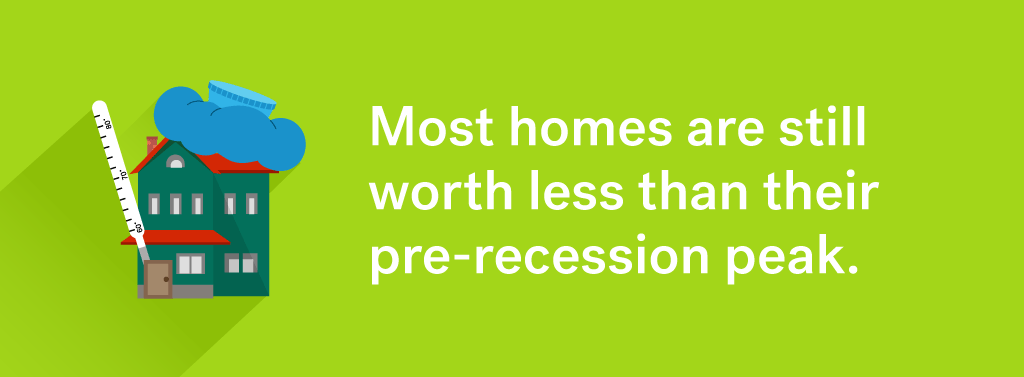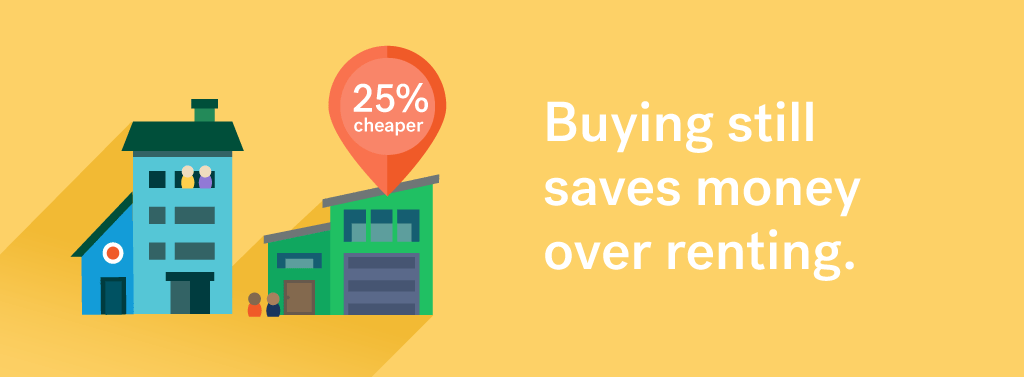
Trulia’s economics research team has spent the year digging into exactly what’s going on out there: How quickly deals are being done, who’s making them, how many are falling through. We looked into where the market has recovered, and where it hasn’t. We did a deep dive into the numbers behind to that eternal question: Is it cheaper to buy or to rent? If you’re looking to buy in 2018, these takeaways mean everything for a successful strategy.
What we learned in 2017

It may seem like boom times in real estate, but in May our data showed that only 34.2 percent of U.S. homes are worth more now than their pre-recession peak. The recovery has been wildly uneven. In places with strong income growth, such as Denver and San Francisco, a full 98 percent of homes have shot past their pre-recession peak prices. But in places with weak income growth, it’s a different picture: Fewer than 3 percent of homes in Las Vegas and Tucson, Ariz. have recovered their pre-recession value.
What you can do in 2018
There’s a lot of talk about rising home prices, but the reality is that if you avoid the hot spots, homes are still more affordable than they were before the last housing peak a decade ago. Focus on whether it’s a good time for you personally to buy, and get prepped if you’re planning to jump in in 2018.
What we learned in 2017

Homes are being snapped up at the fastest clip since we started keeping track in 2012. When homes are in short supply, as they are now, buyers try to get a competitive edge by bidding up the price and also by closing faster. Back in 2012, 57 percent of homes were still on the market two months after being listed—by this June, that number had fallen to 47 percent. The intensity is greatest, of course, in hot markets like San Jose, Oakland, Seattle, San Francisco and Salt Lake City.
What you can do in 2018
Don’t crack under the pressure of a hot market. Understand all the steps involved in the search process and in making an offer so that when you find the right place, you’re ready to make your move.
What we learned in 2017

Home flipping has picked up for the first time in three years, increasing to 6.1 percent of all sales from 5.3 percent in 2015. In January, our data showed that the national capital of house flipping is Las Vegas, where 10.5 percent of homes sold have been flipped, followed by Daytona Beach, at 9 percent.
What you can do in 2018
House flippers, who buy as a short-term investment, tend to drive up prices and intensify bidding. You’re in the majors now. Get into the house-flipping mindset so you can beat investors at their own game and always be ready to make your best offer.
What we learned in 2017

You might think that the best time to find reduced prices on homes for sale would be during the winter off-season, but it turns out that price cuts are actually rarest in December. Reduced prices are most common May through October. Reductions top out just as peak home-buying season is beginning to wane in August, when 13.9 percent of all listings get a price cut. Bargain hunters might try Phoenix, which is the U.S. city where the most homes sell at a reduced price—nearly 1 in 5. Which city had the fewest price cuts? San Francisco. If you’re looking to buy in the city by the bay, take a look at these more affordable neighborhoods that locals love.
What you can do in 2018
Don’t be shy about shopping in the busy summer season, but do go in with some solid high-season shopping advice from the pros.
What we learned in 2017

Every buyer celebrates that moment when an offer is accepted. But don’t pop the cork just yet…deals have been falling through at a faster rate. As of the beginning of 2017, 4.3 percent of sales were falling apart in escrow, up from 1.4 percent at the end of 2014. Starter home deals are the likeliest to fall through, and Las Vegas is the biggest trouble spot, where 7.6 percent of home sales don’t wind up closing.
What you can do in 2018
Don’t think of your offer being accepted as the finish line—it’s the starting line. This is go time to complete your contingencies and assemble your closing team. Should something go wrong while you’re in escrow, know exactly what your rights are as a buyer.
What we learned in 2017

Less than a third of homeowners would choose the same size house if they moved in a year. 37 percent would want a bigger house, Trulia’s research showed in March—but bigger houses aren’t necessarily the solution. Sixty percent of people living in homes over 2,000 square feet would choose a smaller home if they decided to move this year, while only 39 percent would go bigger.
What you can do in 2018
While you’re on the open-house circuit, think beyond what space you need now. Consider how many kids you hope to have and whether aging parents are likely to move in at some point.
What we learned in 2017

Yes, the cost of buying can be daunting, but Trulia’s data shows that if you can put 20 percent down and if you stay in a house for seven years, buying will still save you 37 percent over renting. The few exceptions are in the country’s hottest real estate markets—San Jose, San Francisco, Sacramento, Austin—where renting can save you money over buying if you split rent with a roommate.
What you can do in 2018
Take a deep breath, analyze the cost of renting versus buying where you live, and determine whether the time might be right for you to start looking.


